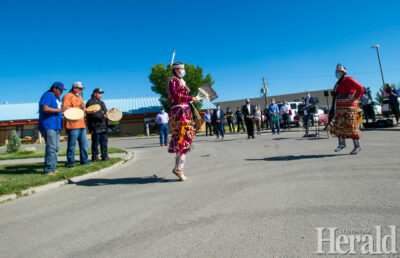Funding impacts ability to help people with addictions
By Lethbridge Herald on July 12, 2024.
 Dancers and drummers take part in a provincial funding announcement in 2020 at the Kainai Continuing Care Centre for construction of two recovery communities in southern Alberta.
Herald file photo by Ian Martens
Dancers and drummers take part in a provincial funding announcement in 2020 at the Kainai Continuing Care Centre for construction of two recovery communities in southern Alberta.
Herald file photo by Ian MartensEditor’s note: This is the third and final part of a series looking at the southern Alberta opioid crisis through an Indigenous lens
Alexandra Noad – LETHBRIDGE HERALD – Local Journalism Initiative Reporter
Trauma is just one piece in the puzzle of addiction among Indigenous peoples. Historically, Indigenous people have suffered from isolation and racism, which is still prevalent to this day.
Walker English, an Indigenous artist from Lethbridge, says the stereotypes about Indigenous people are harmful to everyone.
“I think that there’s a misconception about Native people. There’s a really harmful stereotype that we’re all drunk Indians. That’s very harmful to both sides of the conversation,” said Walker.
He went on to say the best way for people to help Indigenous people is to come together as a family.
While many Indigenous people are in the darkness of addiction, many have come back to the light and have become successful, but it isn’t without hard work and the correct services provided.
Back in 2014, the Blood Tribe had a significant number of overdoses. Many significant leaders in the community banded together to figure out a way to help stop people from falling through the cracks. What they found is even though there were many services, people were struggling find the services because they didn’t know who to call or who to talk to.
What came out of these findings was a task force where people could call one person to direct them to the right recourses for their problems.
However, many of these people have taken significant pay cuts to help their own people, because services on the reserve are not funded by the federal government to the same degree programs are elsewhere.
Leslie Wells, a former senior program manager at AHS, says she took the pay cut to become the Blood Tribe response coordinator to help her people, but still has a family to feed.
“It’s my passion to help. So taking a pay cut to come and help is what I did, but I shouldn’t have to. I should just be paid the same as what I’m getting elsewhere,” said Wells.
The Herald has reached out to the federal government to learn how its funding model for Indigenous health works.
Travis Coleman, Fire Chief and Director of Emergency Services for the Blood Tribe, agrees the Blood Tribe is underfunded in all areas, but more funding would be beneficial to helping to deal with the drug crisis.
“I think we need more funding would definitely help and more funding would definitely get more people in the right avenues. It’s a tough it’s kind of a logjam in times when they go to rehab and you all come out and then they kind of get back into the same situation,” said Coleman.
Coleman suggested there could be recovery communities for people to get clean without temptation.
Wells says under-funding isn’t only affecting the people who work on the reserve, it ultimately affects the people who need the help.
“You’re wanting to work at a treatment centre, but you’re going to get paid $19 (an hour) and you have a degree. You’re not going to work there. You’re going to work someplace else where you get paid so you can make ends meet with your family. So they’ll hire people that are have a passion for it, but do they know do they have the education to work at some place like that?” said Wells.
Through the dedication of people like Wells and Coleman, the Blood Tribe has seen a decrease in opioid poisonings and overdoses, but the work is not done yet.
“The effort is there. We just keep working hard on it,” said Coleman.
21-20


